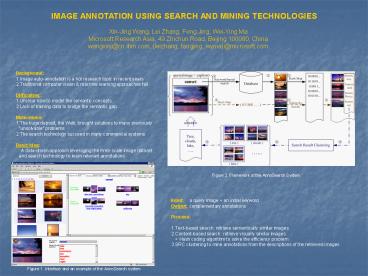IMAGE ANNOTATION USING SEARCH AND MINING TECHNOLOGIES - PowerPoint PPT Presentation
1 / 2
Title:
IMAGE ANNOTATION USING SEARCH AND MINING TECHNOLOGIES
Description:
Microsoft Research Asia, 49 Zhichun Road, Beijing 100080, China ... Clownfish, Japan, Liberty, Lighthouse, Louvre, Paris, Sunset, Tiger, Tree' ... – PowerPoint PPT presentation
Number of Views:112
Avg rating:3.0/5.0
Title: IMAGE ANNOTATION USING SEARCH AND MINING TECHNOLOGIES
1
IMAGE ANNOTATION USING SEARCH AND MINING
TECHNOLOGIES
Xin-Jing Wang, Lei Zhang, Feng Jing, Wei-Ying
Ma Microsoft Research Asia, 49 Zhichun Road,
Beijing 100080, China wangxinj_at_cn.ibm.com,
leizhang, fengjing, wyma_at_microsoft.com
- Background
- Image auto-annotation is a hot research topic in
recent years - Traditional computer vision machine learning
approaches fail - Difficulties
- Unclear how to model the semantic concepts
- Lack of training data to bridge the semantic gap
- Motivations
- 1.The huge deposit, the Web, brought solutions to
many previously unsolvable problems - 2.The search technology succeed in many
commercial systems - Basic Idea
- A data-driven approach leveraging the
Web-scale image dataset and search technology to
learn relevant annotations
Figure 2. Framework of the AnnoSearch System
- Input a query image an initial keyword
- Output complementary annotations
- Process
- Text-based search retrieve semantically similar
images - Content-based search retrieve visually similar
images - gt Hash coding algorithm to solve the efficiency
problem - SRC clustering to mine annotations from the
descriptions of the retrieved images
Figure 1. Interface and an example of the
AnnoSearch system
2
Performance Evaluation Results
- Our Image Deposit
- 2.4 million high-quality photo forum images
with noisy descriptions - Testing Datasets
- Google image query dataset 30 queries from
categories Apple, Beach, Beijing, Bird,
Butterfly, Clouds, Clownfish, Japan, Liberty,
Lighthouse, Louvre, Paris, Sunset, Tiger, Tree - UW Content-based Image Retrieval dataset
categories are Australia, Campus, Cannon beach,
Cherries, Football, Geneva, Green lake,
Indonesia, Iran, Italy, Japan, San juan, Spring
flower, Swiss mountain, Yellowstone. All images
are used as queries. - Evaluation Criterion (Google image query set)
- E (perfect 0.5 x correct - error) /
queries - Conclusion
- High effectiveness ( A much higher precision)
- gt0.6 precision score on Google query set, and
0.38 on UW dataset (5 ground-truth annotations
on average), while it is normally about 0.20.3
for previous annotation approaches - 2. High efficiency
- For the content-based retrieving phrase, it
costs 0.072s for weighted Harming distance
measure. (24,000 candidate images on average,
Dual Intel Pentium 4 Xeon hyper-threaded - CPU, 2G memory)
- 3. No supervised learning phrase and hence can
handle unlimited vocabulary
Figure 3. Examples of annotations produced by
AnnoSearch system. The upper four
rows show a few results on Google image query
dataset. The bottom row shows a
few results on the UW dataset.
Figure 4. Average Precision of annotation vs.
image filtering threshold on the
30 Google query images































